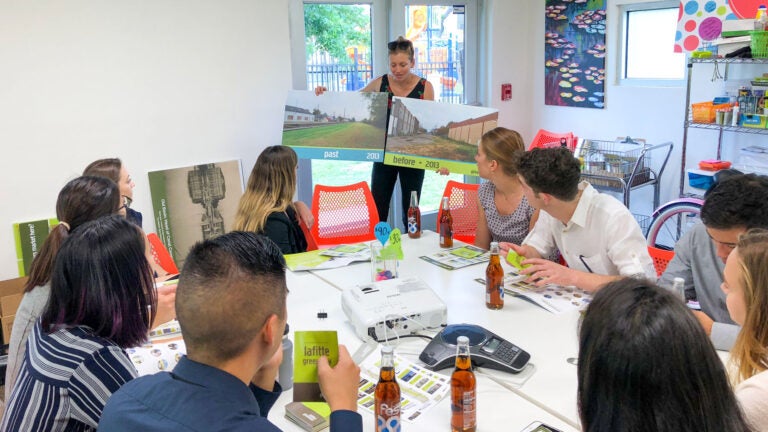
Adjunct instructor Jason Neville led a group of Price students to New Orleans for an undergraduate planning studio. (Photo/Courtesy of Jason Neville)
USC students devise creative ways to revitalize New Orleans
Trojans propose turning an abandoned building into a hotel, among other economic developments that could help generate $6.1 million over five years
A month after Jason Neville came to pursue his Master of Planning degree at the USC Price School of Public Policy in 2005, Hurricane Katrina struck New Orleans. Now an adjunct instructor at the school, he led a recent undergraduate planning studio to his hometown.
He asked his students to create a plan that would capture value along the Lafitte Greenway, a 2.6-mile bicycle and pedestrian trail and green corridor opened in 2015.
During the six-week course, students spent one week in New Orleans conducting site visits, taking tours and meeting with key stakeholders such as nonprofit organizations, community leaders, city officials and real estate developers involved in commercial and affordable housing projects in the area.
The group consisted of USC Price undergraduates Scott Caren, Julie Cho, Olivia Decero, Sara Ioffrida, Riley Jones, Emily Moore, Jae-Jae Segal, Erica Tang and Victoria Toris.
You hear that it’s a city that’s basically under water, but it really hits you once you land and see all the cement walls holding back water.
Riley Jones
“It was my first time going to New Orleans, and you hear that it’s a city that’s basically under water, but it really hits you once you land and see all the cement walls holding back water with houses 20 to 30 feet below those walls,” said Jones, who is pursuing a Bachelor of Science in real estate development.
“New Orleans lost almost half its population, adding all this space in urban areas, and it’s interesting to see how they dealt with some of that property by adding natural parks to soak up some of that water.”
Civic officials appreciate the ideas
Serving as clients for the project were Liana Elliott — a USC alumna and the current deputy chief of staff for New Orleans Mayor LaToya Cantrell — and Jeff Hebert, vice president for adaptation and resilience at the Water Institute and former New Orleans deputy mayor.
Elliott appreciated how the students took to heart her message that New Orleans has been excessively and overly planned by outside entities coming in and trying to help in the 13 years since Katrina hit, so they needed to be mindful of the ways any kind of investment will have an impact on the community.
“They understood the constraints, history and realities of the neighborhood, and stayed within those bounds,” Elliott said.
“They didn’t try to magically waive a requirement or come up with millions of dollars that weren’t there. They were really practical about it, and I think that’s what impressed me the most.”
Community development
Using data from precedents set by other greenways, the students presented how creating an economic development district could help generate $6.1 million over five years from property tax increment, which could be used to fund storm water management, affordable housing, infrastructure and placemaking/art.
The report’s signature element was a catalytic real estate project repurposing the adjacent Lindy Boggs Medical Center building into a hotel taking advantage of tourism.
“It really was the student’s idea to turn that abandoned building into a hotel for the area, and that caught steam with partners in New Orleans because there’s a crackdown on [short-term rentals],” Neville said.
“It’s a great opportunity to take an empty building and turn it into a community scaled hotel to help activate the Greenway, reduce blight and absorb some of the demand for tourists lodging in the area, aiding the city’s goals to reduce [short-term rentals].”
Elliott said she passed the report along to the mayor’s director of economic development.
“This reminded me why the Price School is so amazing, that even a quick lab produces a report much more professional than some of the actual professional reports I’ve seen,” Elliott said. “Their site-specific development for the old hospital I thought was a really great idea, and some of the land value tax structures were applicable not only right there along the Greenway but for other areas.”
The work will be displayed in Lewis Hall this fall.
This is the second class Neville has led that addressed the city’s post-Hurricane Katrina era. Before completing his MPL degree in 2007, he worked with USC Price Professor Dowell Myers and Adjunct Associate Professor Deborah Torres to help design and then serve as a teaching assistant for a course on post-disaster recovery in New Orleans, which won awards from the local and state chapters of the American Planning Association.
“This lab was a nice continuation of USC’s attention to the city of New Orleans as it continues to recover,” Neville said.



